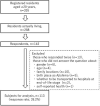Residents in a Remote Island Having Family Members in Distant Areas Showed Higher Preference for Place of End-of-Life Care: The Ajishima Study
- PMID: 33150246
- PMCID: PMC7590377
- DOI: 10.31662/jmaj.2019-0026
Residents in a Remote Island Having Family Members in Distant Areas Showed Higher Preference for Place of End-of-Life Care: The Ajishima Study
Abstract
Introduction: To investigate the proportion of those having preferred place for end-of-life care among residents in a remote island and its association with family composition.
Methods: Cross-sectional questionnaire survey was conducted in Ajishima, an island 23 km away from the coast of Ishinomaki City, northeast of Japan. Between October 2017 and February 2018, the questionnaire was distributed to 288 eligible residents and 113 valid responses were analyzed. Primary outcome was whether the subjects had preferred place for end-of-life care. The explanatory variable was family composition defined as whether having family members inside or outside the island [none (In-/Out-), only inside the island (In+/Out-), only outside the island (In-/Out+), and both inside and outside (In+/Out+)]. Poisson regression analysis was used to calculate the prevalence ratios (PRs) and 95% confidence intervals (CIs) of showing preferred place in each group.
Results: The proportion of those having preferred place for end-of-life care was 72.6% in total. This rate significantly differed across family composition groups: 67.6%, 40.0%, and 82.9% for In+/Out+, In+/Out-, and In-/Out+ groups, respectively. The PR (95%CI) of having preferred place was 0.66 (0.33, 1.36) and 1.26 (1.01, 1.56) for In+/Out- and In-/Out+ groups, respectively, compared with In+/Out+ group.
Conclusions: This study showed that significantly higher preference for place of end-of-life care was seen among residents who had family members only outside the island compared with those who had families both inside and outside. Health care professionals should consider family compositions when initiating end-of-life discussion to residents in remote areas.
Keywords: advance care planning; end-of-life care; family; remote medicine.
Copyright © Japan Medical Association.
Conflict of interest statement
None
Figures
Similar articles
-
Preferences for end-of-life care: A cross-sectional survey of Chinese frail nursing home residents.J Clin Nurs. 2023 Apr;32(7-8):1455-1465. doi: 10.1111/jocn.16483. Epub 2022 Aug 7. J Clin Nurs. 2023. PMID: 35933614
-
Advance care planning preferences in Chinese nursing home residents: results from two cross-sectional studies in Hong Kong and Taiwan.BMC Palliat Care. 2021 Aug 3;20(1):123. doi: 10.1186/s12904-021-00820-4. BMC Palliat Care. 2021. PMID: 34344332 Free PMC article.
-
End-of-life care preferences of nursing home residents: Results of a cross-sectional study.Palliat Med. 2016 Oct;30(9):843-53. doi: 10.1177/0269216316634242. Epub 2016 Mar 9. Palliat Med. 2016. PMID: 26962065
-
Patient Preferences versus Family Physicians' Perceptions Regarding the Place of End-of-Life Care and Death: A Nationwide Study in Taiwan.J Palliat Med. 2015 Jul;18(7):625-30. doi: 10.1089/jpm.2014.0386. Epub 2015 Apr 30. J Palliat Med. 2015. PMID: 25927818 Free PMC article.
-
Thinking ahead about medical treatments in advanced illness: a qualitative study of barriers and enablers in end-of-life care planning with patients and families from ethnically diverse backgrounds.Health Soc Care Deliv Res. 2023 Jun;11(7):1-135. doi: 10.3310/JVFW4781. Health Soc Care Deliv Res. 2023. PMID: 37464868
Cited by
-
Remote Death Certification Using Telemedicine in Japan.Intern Med. 2022 Apr 15;61(8):1291-1294. doi: 10.2169/internalmedicine.6588-20. Epub 2021 Sep 11. Intern Med. 2022. PMID: 34511563 Free PMC article.
References
-
- World Medical Association. Declaration of Lisbon on the Rights of the Patient. 2015:1-6.
-
- Ohmachi I, Arima K, Abe Y, et al. Factors influencing the preferred place of death in community-dwelling elderly people in Japan. Int J Gerontol. 2015;9(1):24-8.
LinkOut - more resources
Full Text Sources
Research Materials


